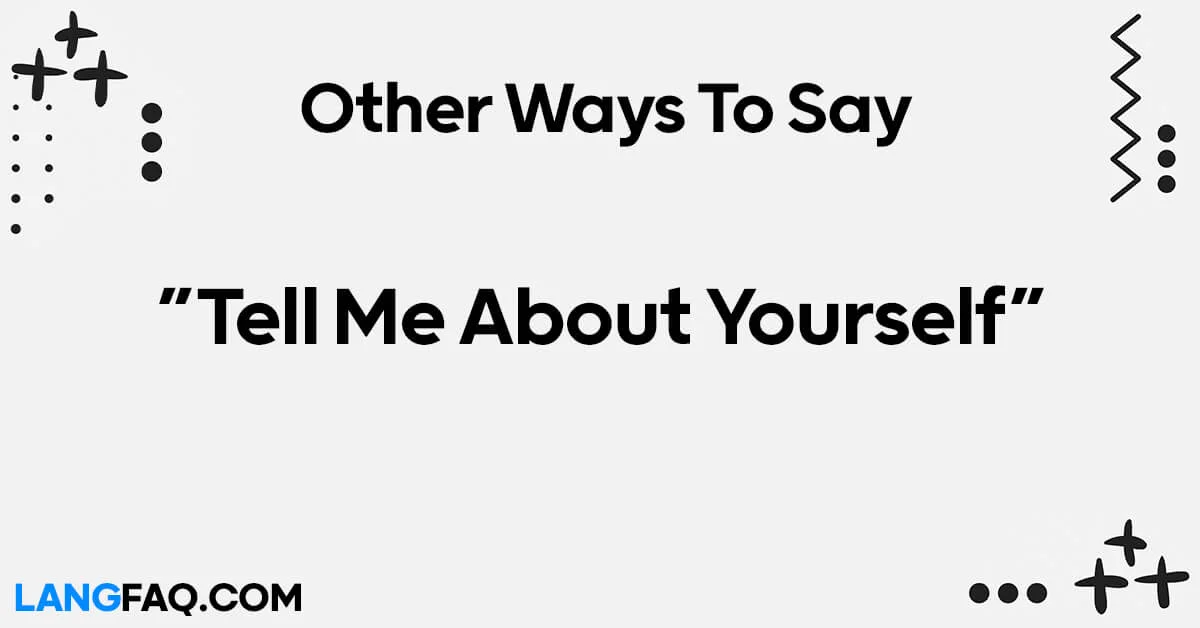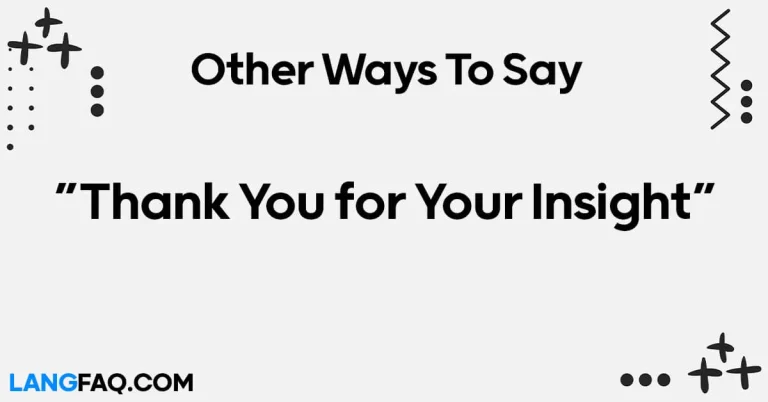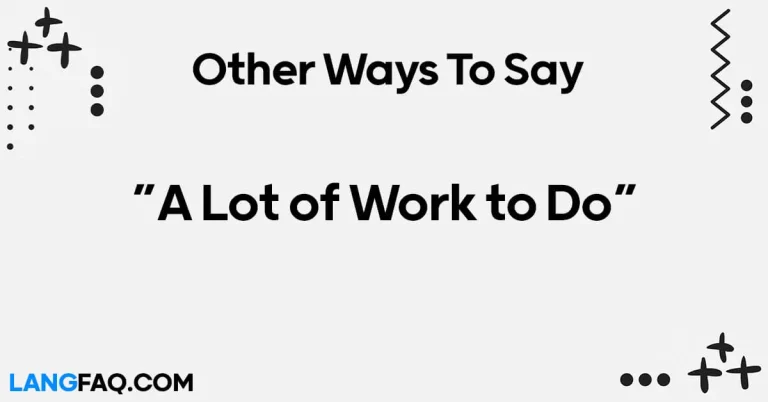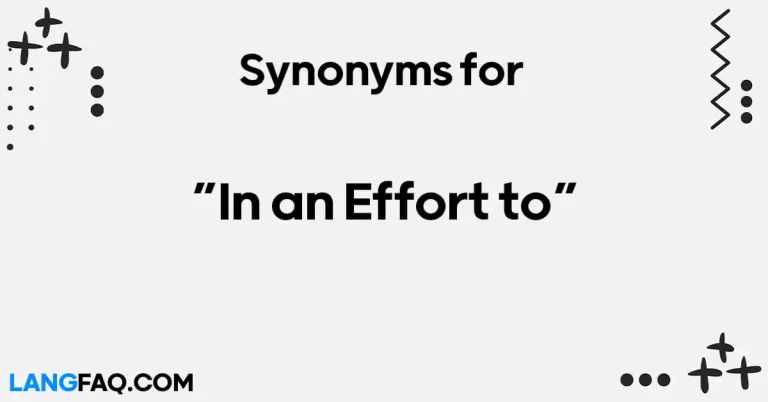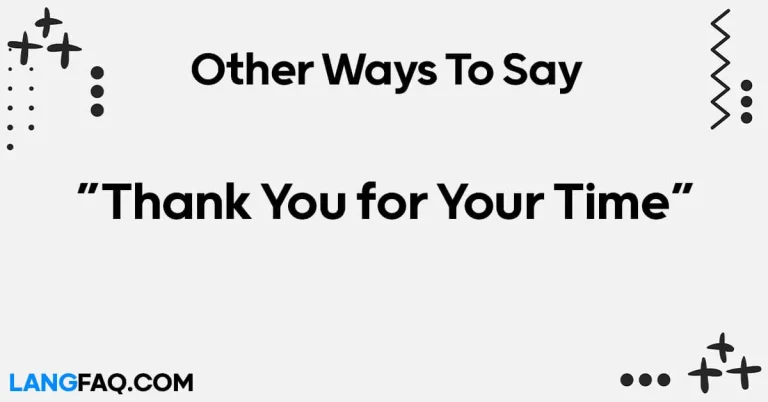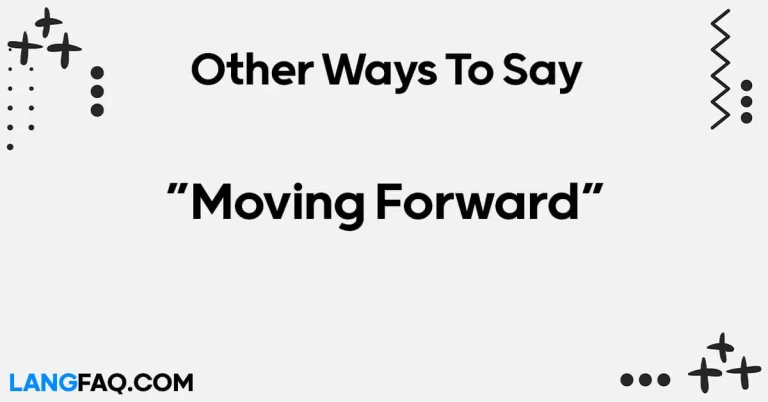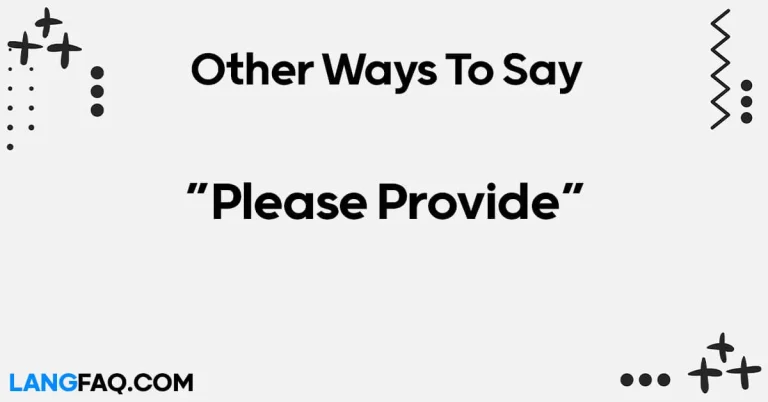In any interview or casual conversation, the question “Tell me about yourself” is like the opening chord of a song—it sets the tone for what follows. However, relying on this tired phrase can dull your presentation and miss opportunities to showcase your uniqueness. Fear not! We’ve compiled 12 dynamic alternatives to invigorate your self-introduction and leave a lasting impression. Let’s delve into these exciting alternatives that will transform your communication style and help you shine in any scenario.
12 Other Ways to Say “Tell Me About Yourself”
Here are 12 alternative phrases to use instead of “Tell Me About Yourself”:
- “Share a bit about your background.”
- “Could you give me a glimpse into your experiences?”
- “Let’s hear your story.”
- “What can you tell me about your journey so far?”
- “Describe your professional path for us.”
- “I’d love to know more about you and what you do.”
- “Paint a picture of your career for me.”
- “How would you introduce yourself in a nutshell?”
- “Give us a snapshot of who you are professionally.”
- “Tell us a little about your professional background.”
- “Could you provide some insight into your professional history?”
- “Walk us through your career journey.”
Here’s a table with the meanings and examples of the alternative phrases to “Tell Me About Yourself”:
| Alternative Phrase | Meaning | Example |
|---|---|---|
| Share a bit about your background | Provide some information about yourself | “Sure, I grew up in New York City and studied finance in college.” |
| Could you give me a glimpse into your experiences? | Offer insight into your past experiences | “Certainly, I’ve had the opportunity to work in various industries.” |
| Let’s hear your story | Invite someone to share their narrative | “I’d love to hear how you got to where you are today.” |
| What can you tell me about your journey so far? | Discuss your life or career journey | “My journey has been filled with challenges and exciting opportunities.” |
| Describe your professional path for us | Explain your career trajectory | “I started as an intern and worked my way up to a managerial role.” |
| I’d love to know more about you and what you do | Express interest in learning about someone | “Tell me more about your role and responsibilities.” |
| Paint a picture of your career for me | Provide a clear overview of your career | “Could you paint a picture of your career progression?” |
| How would you introduce yourself in a nutshell? | Summarize yourself briefly | “If you had to introduce yourself in a few sentences, what would you say?” |
| Give us a snapshot of who you are professionally | Offer a brief overview of your professional self | “Can you give us a snapshot of your professional background?” |
| Tell us a little about your professional background | Provide some information about your professional history | “Could you tell us a little about your experience in marketing?” |
| Could you provide some insight into your professional history? | Offer insight into your past professional experiences | “I’m interested in hearing more about your journey in project management.” |
| Walk us through your career journey | Explain your career path in detail | “Could you walk us through the key milestones of your career?” |
These alternative phrases provide diverse ways to invite individuals to share their personal or professional experiences. By using these varied expressions, conversations can become more engaging and insightful, fostering deeper connections and understanding.
Is It Correct to Say “Tell Me About Yourself”?
Yes, “Tell me about yourself” is a common and correct phrase used to initiate a conversation or interview. It’s often used as an open-ended question to encourage someone to share information about their background, experiences, interests, and aspirations. This phrase is frequently used in job interviews, networking events, or casual conversations as a way to get to know someone better. It allows the person being asked to provide a personalized response tailored to the context of the conversation. Overall, “Tell me about yourself” is a perfectly acceptable and widely used phrase in various social and professional settings.
Professional Mail Example With “Tell Me About Yourself”
Subject: Introduction and Brief Background
Dear [Recipient’s Name],
I hope this email finds you well. My name is [Your Name], and I am reaching out to introduce myself and provide a brief overview of my background.
Tell me about yourself? Well, I am a dedicated and results-oriented professional with over [number of years] years of experience in [industry/field]. Throughout my career, I have had the opportunity to [highlight one or two key experiences or achievements relevant to the recipient’s interests or needs]. My passion for [mention relevant skills or interests] has driven me to [mention a specific goal or accomplishment].
In my current role at [Current Company/Organization], I have been responsible for [briefly describe your current responsibilities and achievements]. Additionally, I have a strong track record of [mention another relevant accomplishment or skill].
Outside of work, I enjoy [mention hobbies or interests relevant to building rapport with the recipient, if applicable].
I am reaching out because [mention reason for reaching out, such as networking, seeking opportunities, etc.]. I am particularly interested in [mention specific interests or goals related to the recipient’s field or expertise].
I would love the opportunity to connect with you further to discuss [mention potential topics for discussion, such as collaboration opportunities, industry trends, etc.]. Please let me know if you are available for a brief call or meeting at your earliest convenience.
Thank you for considering my introduction, and I look forward to the possibility of connecting with you soon.
Warm regards, [Your Name] [Your Contact Information]
Share a bit about your background
Meaning and Usage:
“Share a bit about your background” is a friendly and informal way to ask someone to provide information about their personal or professional history. It invites the individual to share relevant details about themselves, such as where they’re from, their educational background, or their career path.
When and Where to Use:
This phrase can be used in both casual and professional settings. In casual conversations, it can be a great icebreaker to get to know someone better. In professional contexts, it’s often used during interviews, networking events, or introductions to learn more about a person’s qualifications and experiences.
Pros and Cons:
- Pros: Encourages openness and sharing, fosters rapport and connection, provides valuable insights into the person’s background.
- Cons: Can be seen as overly casual in very formal settings, may lead to lengthy responses if not managed properly.
Example Sentence:
- “Hey, nice to meet you! Can you share a bit about your background?”
- “Sure, I grew up in New York City and studied finance in college.”
Variations for Different Situations:
- Colleagues: “Hey, we’ve been working together for a while now, but I realized I don’t know much about your background. Mind sharing a bit?”
- Friends: “So, I know you’ve mentioned you traveled a lot as a kid. Can you share a bit more about your background and how that shaped you?”
- Mentor-Mentee: “As your mentor, I’m curious to learn more about your background. Can you tell me about your experiences that led you to pursue this field?”
Grammar/Usage Rules:
- Use “a bit” to indicate a small amount of information, making the question feel less intrusive.
- Use “about your background” to specify what type of information you’re asking for.
Dictionary Insights:
According to the Cambridge Dictionary, “background” refers to “the details of a person’s family, education, experience, etc.” This aligns with the intention of the phrase to inquire about someone’s personal or professional history.
Tips:
- Be prepared to reciprocate and share about your own background to keep the conversation balanced.
- Avoid asking overly personal questions, especially in professional settings, to respect boundaries.
Example Email Sample:
Subject: Getting to Know Each Other Better
Hi [Name],
I hope you’re doing well! As we continue to collaborate on projects together, I realized there’s still a lot I don’t know about your background. I’d love to learn more about where you’re from, your educational journey, and what led you to pursue your current career path. Let’s grab coffee sometime and chat!
Looking forward to hearing more about you, [Your Name]
Could you give me a glimpse into your experiences?
Meaning and Usage:
“Could you give me a glimpse into your experiences?” is a polite and formal way to ask someone to provide insight into their past experiences. It implies a desire to learn more about the person’s background, accomplishments, and challenges they’ve faced.
When and Where to Use:
This phrase is best suited for formal or professional contexts, such as job interviews, networking events, or meetings where individuals are expected to share relevant experiences and qualifications.
Pros and Cons:
- Pros: Conveys interest and curiosity, encourages the person to share meaningful insights, maintains a professional tone.
- Cons: May sound slightly formal for very casual conversations, could be perceived as too indirect if clarity is needed.
Example Sentence:
- “Thank you for taking the time to meet with me. Could you give me a glimpse into your experiences?”
- “Of course, throughout my career, I’ve had the opportunity to work in various industries and tackle a range of challenges.”
Variations for Different Situations:
- Colleagues: “I’ve always admired your expertise in this area. Could you give me a glimpse into your experiences that have led to your success?”
- Friends: “Hey, I know you’ve traveled extensively. Could you give me a glimpse into your experiences abroad?”
- Mentor-Mentee: “As your mentee, I’m eager to learn from your experiences. Could you give me a glimpse into your professional journey and the lessons you’ve learned?”
Grammar/Usage Rules:
- Use “could you” to make the request more polite and formal.
- Use “give me a glimpse into” to suggest a brief overview or insight into the person’s experiences.
Dictionary Insights:
According to the Cambridge Dictionary, “glimpse” refers to “a brief or quick view or look.” This aligns with the intention of the phrase to request a brief insight into someone’s experiences.
Tips:
- Be prepared to actively listen and engage with the insights the person shares.
- Follow up with specific questions to delve deeper into areas of interest or relevance.
Example Email Sample:
Subject: Request for Insights
Dear [Name],
I hope this email finds you well. I recently came across your profile and was impressed by your wealth of experiences in [industry/field]. As I’m exploring opportunities in this area, I was wondering if you could give me a glimpse into your experiences and share some insights that have shaped your journey.
Looking forward to hearing from you, [Your Name]
Let’s hear your story
Meaning and Usage:
“Let’s hear your story” is an open and inviting phrase used to encourage someone to share their personal or professional narrative. It implies a genuine interest in listening to the person’s experiences, challenges, and successes.
When and Where to Use:
This phrase is versatile and can be used in both formal and informal settings. It’s particularly effective in situations where storytelling and personal connections are valued, such as networking events, team meetings, or one-on-one conversations.
Pros and Cons:
- Pros: Creates a welcoming and inclusive atmosphere, encourages authenticity and vulnerability, fosters deeper connections.
- Cons: May be too casual for very formal or structured environments, could lead to lengthy responses if not managed effectively.
Example Sentence:
- “As we get started, let’s hear your story. What experiences have shaped your journey to this point?”
- “I’d love to hear your story—how did you end up pursuing a career in marketing?”
Variations for Different Situations:
- Colleagues: “We’ve all got unique stories to share. Let’s hear your story and what brought you to this team.”
- Friends: “We’ve been friends for years, but I realize I don’t know much about your journey. Let’s hear your story!”
- Mentor-Mentee: “As your mentor, I’m here to support you in your journey. Let’s hear your story and what goals you’re working towards.”
Grammar/Usage Rules:
- Use “let’s” to suggest a collaborative and inclusive approach to storytelling.
- Use “your story” to indicate a personal narrative, allowing the person to share relevant experiences and insights.
Dictionary Insights:
According to the Cambridge Dictionary, “story” refers to “a description, either true or imagined, of a connected series of events.” This aligns with the intention of the phrase to invite someone to share their personal or professional narrative.
Tips:
- Be an active listener and show genuine interest in the person’s story.
- Ask follow-up questions to deepen the conversation and demonstrate engagement.
Example Email Sample:
Subject: Share Your Story
Hi [Name],
I hope you’re doing well! As we continue to collaborate on projects together, I realized there’s still so much I don’t know about your journey. I’d love to hear your story—what experiences have shaped your career path and brought you to where you are today?
Looking forward to catching up, [Your Name]
What can you tell me about your journey so far?
Meaning and Usage:
“What can you tell me about your journey so far?” is a straightforward and direct way to inquire about someone’s life or career journey. It invites the person to provide an overview of their experiences, accomplishments, and challenges.
When and Where to Use:
This phrase is commonly used in professional settings, such as job interviews, networking events, or career development conversations. It’s often employed by interviewers or mentors seeking to gain insights into a person’s background and qualifications.
Pros and Cons:
- Pros: Clearly communicates the intention to learn about the person’s journey, provides a broad framework for sharing experiences, allows for flexibility in response.
- Cons: May feel slightly formal or impersonal, could elicit generic responses if not supplemented with specific prompts or questions.
Example Sentence:
- “As we begin the interview, what can you tell me about your journey so far? I’d love to hear about the experiences that have shaped your career.”
- “Before we dive into the specifics, can you tell me about your journey so far and how you got to where you are today?”
Variations for Different Situations:
- Colleagues: “I’ve always admired your career path. What can you tell me about your journey so far?”
- Friends: “We’ve known each other for years, but I’d love to hear more about your journey. What can you tell me about it?”
- Mentor-Mentee: “As your mentor, I’m interested in learning more about your journey so far. What can you tell me about the experiences that have shaped your career aspirations?”
Grammar/Usage Rules:
- Use “what can you tell me” to prompt the person to share their experiences and insights.
- Use “journey so far” to specify the timeframe and scope of the inquiry.
Dictionary Insights:
According to the Cambridge Dictionary, “journey” refers to “the process of traveling from one place to another, especially in a vehicle.” In this context, it metaphorically represents the person’s life or career path.
Tips:
- Encourage the person to highlight key milestones, challenges, and achievements in their journey.
- Be prepared to actively listen and engage with the insights and experiences shared.
Example Email Sample:
Subject: Request for Insights on Your Journey
Dear [Name],
I hope this email finds you well. As we continue to work together, I’m keen to learn more about your journey so far. Could you tell me about the experiences that have shaped your career path and led you to where you are today?
Looking forward to hearing from you, [Your Name]
Describe your professional path for us
Meaning and Usage:
“Describe your professional path for us” is a request for an individual to outline their career trajectory, highlighting key milestones, experiences, and achievements along the way. It provides an opportunity for the person to showcase their professional growth and development.
When and Where to Use:
This phrase is commonly used in formal settings, such as job interviews, career development discussions, or professional networking events. It’s often employed by interviewers, mentors, or colleagues seeking a comprehensive overview of someone’s professional journey.
Pros and Cons:
- Pros: Clearly communicates the intention to learn about the person’s career path, allows for a structured and detailed response, provides valuable insights into the person’s qualifications and experiences.
- Cons: May feel slightly formal or directive, could lead to lengthy responses if not managed effectively.
Example Sentence:
- “As part of the interview process, could you describe your professional path for us? We’re interested in learning more about your career trajectory and the experiences that have shaped it.”
- “During our career development session, I’d like you to describe your professional path for us. It will help us identify opportunities for growth and development.”
Variations for Different Situations:
- Colleagues: “We’re updating our team profiles, and I’d like you to describe your professional path for us. It’ll help us highlight your expertise and contributions within the team.”
- Friends: “We’ve all taken different career paths. Could you describe your professional journey for us? I’m sure we could all learn from each other’s experiences.”
- Mentor-Mentee: “As your mentor, I’d like you to describe your professional path for us. It’ll give us a better understanding of your career goals and aspirations.”
Grammar/Usage Rules:
- Use “describe” to prompt the person to provide a detailed overview of their professional path.
- Use “for us” to specify the audience or purpose of the request.
Dictionary Insights:
According to the Cambridge Dictionary, “describe” means “to say or write what someone or something is like.” In this context, it encourages the person to articulate their professional experiences and accomplishments.
Tips:
- Encourage the person to focus on significant milestones, transitions, and achievements in their career path.
- Provide guidance or prompts if the person seems unsure how to structure their response.
Example Email Sample:
Subject: Request to Describe Your Professional Path
Dear [Name],
I hope you’re doing well. As we continue to explore opportunities for growth and development, I’d like to invite you to describe your professional path for us. This will help us gain a better understanding of your career journey and identify areas for support and advancement.
Looking forward to hearing from you, [Your Name]
I’d love to know more about you and what you do
Meaning and Usage:
“I’d love to know more about you and what you do” is a friendly and informal way to express interest in learning about someone’s personal or professional life. It conveys curiosity and openness to hearing more about the person’s experiences and interests.
When and Where to Use:
This phrase can be used in various settings, including casual conversations, networking events, or introductions. It’s particularly effective in situations where building rapport and establishing connections are valued.
Pros and Cons:
- Pros: Conveys genuine interest and curiosity, fosters rapport and connection, invites the person to share relevant information about themselves.
- Cons: May feel overly familiar or informal in very formal settings, could lead to generic responses if not supplemented with specific questions or prompts.
Example Sentence:
- “Hey, we’ve just met, but I’d love to know more about you and what you do. What’s a typical day like for you?”
- “I’ve heard great things about your work. I’d love to know more about you and what you do. Could you share a bit about your role and responsibilities?”
Variations for Different Situations:
- Colleagues: “We’ve been working together for a while now, but I realize I don’t know much about your day-to-day. I’d love to know more about you and what you do.”
- Friends: “We’ve known each other for years, but I feel like there’s still so much I don’t know about your work. I’d love to know more about you and what you do.”
- Mentor-Mentee: “As your mentor, I’m here to support you in your professional journey. I’d love to know more about you and what you do. Could you share some insights into your current projects and goals?”
Grammar/Usage Rules:
- Use “I’d love to know more about you” to express genuine interest and curiosity.
- Use “and what you do” to specify the area of interest or topic for discussion.
Dictionary Insights:
According to the Cambridge Dictionary, “know more about” means “to have more information about something.” In this context, it suggests a desire to learn more about the person’s background, interests, or profession.
Tips:
- Be an active listener and engage with the information the person shares.
- Ask follow-up questions to deepen the conversation and demonstrate interest.
Example Email Sample:
Subject: Let’s Connect!
Hi [Name],
I hope you’re doing well. I recently came across your profile and was intrigued by your work. I’d love to know more about you and what you do—could we set up a time to chat?
Looking forward to hearing from you, [Your Name]
Paint a picture of your career for me
Meaning and Usage:
“Paint a picture of your career for me” is a metaphorical way to request a detailed overview of someone’s professional journey. It implies creating a vivid and comprehensive representation of the person’s career path, including key experiences, achievements, and milestones.
When and Where to Use:
This phrase is commonly used in formal settings, such as job interviews, career counseling sessions, or professional development discussions. It’s often employed by interviewers, mentors, or career coaches seeking a holistic understanding of someone’s career trajectory.
Pros and Cons:
- Pros: Evokes imagery and visualization, encourages the person to provide a detailed and nuanced account of their career, allows for a narrative approach to storytelling.
- Cons: May feel slightly abstract or metaphorical for very structured or formal environments, could lead to lengthy responses if not managed effectively.
Example Sentence:
- “As we delve into your background, I’d like you to paint a picture of your career for me. Take us through the highs, lows, and everything in between.”
- “Before we discuss potential opportunities, could you paint a picture of your career for me? I’d like to understand how your experiences align with our organization’s needs.”
Variations for Different Situations:
- Colleagues: “We’ve all had unique career journeys. Could you paint a picture of your career for me? It’ll help us appreciate your contributions to the team.”
- Friends: “We’ve shared so many stories over the years, but I’d love to hear you paint a picture of your career for me. What have been the defining moments?”
- Mentor-Mentee: “As your mentor, I’m here to support your growth. Could you paint a picture of your career for me? It’ll give us insight into your aspirations and areas for development.”
Grammar/Usage Rules:
- Use “paint a picture” metaphorically to suggest creating a vivid representation or narrative of someone’s career.
- Use “for me” to specify the audience or purpose of the request.
Dictionary Insights:
According to the Cambridge Dictionary, “paint a picture” means “to describe something very clearly, so that you can imagine it.” In this context, it encourages the person to provide a detailed and descriptive account of their career journey.
Tips:
- Encourage the person to highlight key moments, lessons learned, and future aspirations in their career narrative.
- Provide prompts or follow-up questions to guide the storytelling process and maintain focus.
Example Email Sample:
Subject: Request for Career Insights
Dear [Name],
I hope this email finds you well. As we continue to explore opportunities for professional development, I’d like to invite you to paint a picture of your career for me. This will help us gain a deeper understanding of your experiences and aspirations.
Looking forward to hearing from you, [Your Name]
How would you introduce yourself in a nutshell?
Meaning and Usage:
“How would you introduce yourself in a nutshell?” is a request for a concise and focused overview of someone’s personal or professional identity. It invites the person to summarize key aspects of themselves in a brief and impactful manner.
When and Where to Use:
This phrase is versatile and can be used in various settings, including job interviews, networking events, or introductions. It’s often employed by interviewers, mentors, or colleagues seeking a quick introduction to someone’s background and qualifications.
Pros and Cons:
- Pros: Encourages clarity and conciseness, allows for a focused and impactful introduction, provides a snapshot of the person’s identity and expertise.
- Cons: May feel slightly directive or formulaic, could lead to oversimplification if not supplemented with follow-up questions or prompts.
Example Sentence:
- “As we kick off the interview, could you introduce yourself in a nutshell? Give us a quick overview of who you are and what you bring to the table.”
- “Before we dive into the details, I’d like you to introduce yourself in a nutshell. What are the key highlights of your background and experiences?”
Variations for Different Situations:
- Colleagues: “We’re welcoming new members to the team. How would you introduce yourself in a nutshell to your new colleagues?”
- Friends: “We’ve got some new faces joining our friend group. How would you introduce yourself in a nutshell to someone new?”
- Mentor-Mentee: “As your mentor, I’m here to support your professional growth. How would you introduce yourself in a nutshell to a potential employer or mentor?”
Grammar/Usage Rules:
- Use “how would you” to prompt the person to imagine and articulate their introduction.
- Use “in a nutshell” to suggest a brief and concise summary.
Dictionary Insights:
According to the Cambridge Dictionary, “in a nutshell” means “using as few words as possible.” In this context, it encourages the person to provide a concise and focused introduction to themselves.
Tips:
- Encourage the person to highlight key strengths, experiences, and achievements in their nutshell introduction.
- Emphasize the importance of clarity and impact in crafting their introduction.
Example Email Sample:
Subject: Quick Introduction Request
Hi [Name],
I hope you’re doing well! As we prepare for our upcoming meeting, I’d like to kick things off with a quick introduction. Could you introduce yourself in a nutshell? It’ll help us get to know each other better and set the stage for our discussion.
Looking forward to connecting, [Your Name]
Give us a snapshot of who you are professionally
Meaning and Usage:
“Give us a snapshot of who you are professionally” is a request for a concise overview of someone’s professional identity. It asks the person to provide a brief summary of their qualifications, experiences, and areas of expertise.
When and Where to Use:
This phrase is commonly used in professional settings, such as job interviews, networking events, or introductions. It’s often employed by interviewers, mentors, or colleagues seeking to quickly understand someone’s professional background and capabilities.
Pros and Cons:
- Pros: Encourages clarity and brevity, allows for a focused and impactful introduction, provides a snapshot of the person’s professional identity and value proposition.
- Cons: May feel slightly formal or directive, could lead to oversimplification if not supplemented with follow-up questions or prompts.
Example Sentence:
- “Before we proceed, could you give us a snapshot of who you are professionally? Highlight your key skills, experiences, and achievements.”
- “As part of the networking event, we’d like each participant to give a snapshot of who they are professionally. It’ll help us identify potential areas for collaboration.”
Variations for Different Situations:
- Colleagues: “We’re updating our team profiles. Can you give us a snapshot of who you are professionally? It’ll help us showcase your expertise within the team.”
- Friends: “We’ve all got unique professional journeys. Can you give us a snapshot of who you are professionally? It’ll help us understand how we can support each other.”
- Mentor-Mentee: “As your mentor, I’m here to guide your professional development. Can you give us a snapshot of who you are professionally? It’ll help us identify areas for growth and improvement.”
Grammar/Usage Rules:
- Use “give us” to indicate the audience or purpose of the request.
- Use “snapshot” to suggest a brief and focused overview.
Dictionary Insights:
According to the Cambridge Dictionary, “snapshot” refers to “a quick, informal picture or view.” In this context, it encourages the person to provide a concise and informal overview of their professional identity.
Tips:
- Encourage the person to highlight key skills, experiences, and achievements relevant to the context or audience.
- Emphasize the importance of brevity and clarity in crafting their professional snapshot.
Example Email Sample:
Subject: Quick Introduction Request
Hi [Name],
I hope you’re doing well! As we prepare for our upcoming meeting, I’d like to start by asking everyone to give us a snapshot of who they are professionally. Could you highlight your key skills, experiences, and achievements? It’ll help us kick things off on the right note.
Looking forward to connecting, [Your Name]
Tell us a little about your professional background
Meaning and Usage:
“Tell us a little about your professional background” is a request for a brief overview of someone’s career history and experiences. It invites the person to share relevant details about their educational qualifications, previous roles, and key accomplishments.
When and Where to Use:
This phrase is commonly used in formal settings, such as job interviews, networking events, or introductions. It’s often employed by interviewers, recruiters, or colleagues seeking to understand someone’s professional journey and qualifications.
Pros and Cons:
- Pros: Provides a structured and focused approach to learning about someone’s professional background, allows for a concise and informative response.
- Cons: May feel slightly formal or directive, could lead to oversimplification if not supplemented with follow-up questions or prompts.
Example Sentence:
- “As part of the interview process, could you tell us a little about your professional background? We’re interested in learning more about your previous roles and experiences.”
- “Before we dive into the details, could you tell us a little about your professional background? It’ll help us understand your qualifications and expertise.”
Variations for Different Situations:
- Colleagues: “We’re updating our team profiles. Can you tell us a little about your professional background? It’ll help us showcase your expertise within the team.”
- Friends: “We’ve all got unique career journeys. Can you tell us a little about your professional background? It’ll help us understand how we can support each other.”
- Mentor-Mentee: “As your mentor, I’m here to guide your professional development. Can you tell us a little about your professional background? It’ll help us identify areas for growth and improvement.”
Grammar/Usage Rules:
- Use “tell us” to prompt the person to share information about their professional background.
- Use “a little” to suggest a brief and concise overview.
Dictionary Insights:
According to the Cambridge Dictionary, “professional background” refers to “the education, experience, and skills that a person has, especially in a job.” In this context, it encompasses various aspects of someone’s career history and qualifications.
Tips:
- Encourage the person to highlight key roles, responsibilities, and achievements in their professional background.
- Provide prompts or follow-up questions to guide the conversation and ensure a comprehensive overview.
Example Email Sample:
Subject: Introduction Request
Hi [Name],
I hope you’re doing well! As we continue to collaborate on projects together, I’d like to learn more about your professional background. Could you tell us a little about your previous roles and experiences? It’ll help us appreciate your expertise and contributions within the team.
Looking forward to connecting, [Your Name]
Share a glimpse of your career journey
Meaning and Usage:
“Share a glimpse of your career journey” is a request for a brief overview of someone’s professional path, highlighting key milestones and experiences along the way. It invites the person to provide a snapshot of their career trajectory.
When and Where to Use:
This phrase is versatile and can be used in various settings, including job interviews, networking events, or introductions. It’s often employed by interviewers, mentors, or colleagues seeking to gain insights into someone’s career journey and aspirations.
Pros and Cons:
- Pros: Encourages storytelling and narrative, provides a snapshot of the person’s career trajectory, allows for a concise and focused response.
- Cons: May feel slightly informal or casual in very formal settings, could lead to oversimplification if not supplemented with follow-up questions or prompts.
Example Sentence:
- “Before we delve into the details, could you share a glimpse of your career journey? Highlight some of the key experiences and milestones that have shaped your path.”
- “As part of the team-building exercise, we’d like everyone to share a glimpse of their career journey. It’ll help us understand each other’s backgrounds and perspectives.”
Variations for Different Situations:
- Colleagues: “We’ve all taken different career paths. Can you share a glimpse of your career journey with us? It’ll help us appreciate the diversity of experiences within the team.”
- Friends: “We’ve known each other for years, but I feel like I don’t know much about your career journey. Can you share a glimpse of it with me?”
- Mentor-Mentee: “As your mentor, I’m interested in learning more about your career journey. Can you share a glimpse of it with me? It’ll help us identify areas for growth and development.”
Grammar/Usage Rules:
- Use “share” to prompt the person to provide insights into their career journey.
- Use “a glimpse” to suggest a brief and focused overview.
Dictionary Insights:
According to the Cambridge Dictionary, “glimpse” means “a quick look at someone or something that does not allow you to see them clearly.” In this context, it encourages the person to provide a concise and selective overview of their career journey.
Tips:
- Encourage the person to focus on key turning points, challenges, and achievements in their career journey.
- Emphasize the importance of brevity and relevance in sharing their career glimpse.
Example Email Sample:
Subject: Icebreaker Activity – Share Your Career Journey
Hi [Name],
I hope you’re doing well! As part of our upcoming team-building session, we’re inviting everyone to share a glimpse of their career journey. Could you highlight some key experiences and milestones that have shaped your professional path? It’ll help us get to know each other better and foster stronger connections within the team.
Looking forward to hearing from you, [Your Name]
Can you walk us through your professional evolution?
Meaning and Usage:
“Can you walk us through your professional evolution?” is a request for a detailed overview of someone’s career progression and development over time. It invites the person to narrate the various stages and transitions in their professional journey.
When and Where to Use:
This phrase is commonly used in formal settings, such as job interviews, career counseling sessions, or performance evaluations. It’s often employed by interviewers, mentors, or supervisors seeking to understand someone’s career trajectory and growth.
Pros and Cons:
- Pros: Encourages a structured and comprehensive approach to sharing one’s career journey, allows for an in-depth exploration of key milestones and transitions.
- Cons: May feel slightly formal or directive, could lead to lengthy responses if not managed effectively.
Example Sentence:
- “As part of the interview process, could you walk us through your professional evolution? Take us through the various stages and transitions in your career.”
- “Before we discuss potential career opportunities, I’d like you to walk us through your professional evolution. It’ll help us understand your growth and development over time.”
Variations for Different Situations:
- Colleagues: “We’re all at different stages in our careers. Can you walk us through your professional evolution? It’ll help us appreciate the diversity of experiences within the team.”
- Friends: “We’ve known each other for years, but I’d love to hear more about your professional evolution. Can you walk us through it?”
- Mentor-Mentee: “As your mentor, I’m interested in learning more about your career journey. Can you walk us through your professional evolution? It’ll help us identify areas for growth and development.”
Grammar/Usage Rules:
- Use “walk us through” to suggest a guided exploration of someone’s professional evolution.
- Use “professional evolution” to encompass the various stages and transitions in one’s career.
Dictionary Insights:
According to the Cambridge Dictionary, “evolution” refers to “the way in which living things change and develop over millions of years.” In this context, it metaphorically represents the changes and developments in someone’s career over time.
Tips:
- Encourage the person to highlight key career milestones, transitions, and learnings in their professional evolution.
- Provide prompts or follow-up questions to guide the narrative and maintain focus.
Example Email Sample:
Subject: Request for Career Insights
Hi [Name],
I hope this email finds you well. As we continue to explore opportunities for growth and development, I’d like to invite you to walk us through your professional evolution. Could you share the various stages and transitions in your career, along with any key learnings and achievements? It’ll help us gain a deeper understanding of your journey and aspirations.
Looking forward to hearing from you, [Your Name]
FAQs
- What is the importance of crafting a compelling self-introduction? Crafting a compelling self-introduction is crucial as it sets the tone for any interaction, whether it’s an interview, networking event, or casual conversation. A dynamic self-introduction captures attention, establishes rapport, and showcases your unique qualities and experiences.
- How can I make my self-introduction more engaging and memorable? To make your self-introduction more engaging and memorable, consider incorporating storytelling, highlighting your professional journey, articulating your unique value proposition, and infusing enthusiasm and authenticity. By sharing meaningful anecdotes, accomplishments, and aspirations, you create a lasting impression that resonates with your audience.
- What are some creative alternatives to the traditional “Tell me about yourself” question? Some creative alternatives to the traditional “Tell me about yourself” question include crafting a narrative, highlighting your passions and interests, sharing your vision for the future, and showcasing your problem-solving skills and leadership style. These alternatives offer opportunities to showcase your personality, accomplishments, and aspirations in a compelling and memorable way.
- How can I effectively communicate my value proposition during a self-introduction? To effectively communicate your value proposition during a self-introduction, focus on articulating your unique qualities, skills, and experiences that set you apart from others. Emphasize the tangible benefits and contributions you can offer, whether it’s solving a specific problem, driving innovation, or fostering collaboration. By clearly communicating your value proposition, you position yourself as a valuable asset to any organization or opportunity.
- Why is it important to embrace authenticity and vulnerability in a self-introduction? Embracing authenticity and vulnerability in a self-introduction is important as it fosters genuine connections and trust. By sharing authentic stories and experiences, including moments of vulnerability and growth, you create an emotional connection with your audience. This authenticity not only enhances your credibility but also invites others to engage more deeply and authentically with you.
- How can I use open-ended questions to facilitate conversation during a self-introduction? To use open-ended questions effectively during a self-introduction, frame your introduction in a way that invites dialogue and interaction. Ask thought-provoking questions or prompts that encourage others to share their perspectives, experiences, and aspirations. By creating opportunities for conversation and connection, you enrich the interaction and leave a lasting impression.
Conclusion
In conclusion, mastering the art of self-introduction is a powerful skill that can open doors and create opportunities. By exploring these 12 dynamic alternatives to the traditional “Tell me about yourself” question, you can unlock your confidence, captivate your audience, and leave a lasting impression. Whether you’re navigating a job interview, networking event, or social gathering, remember to infuse your self-introduction with authenticity, enthusiasm, and creativity. Embrace the opportunity to share your story, showcase your unique value, and connect with others on a meaningful level. Here’s to unlocking your confidence and seizing every opportunity that comes your way!

